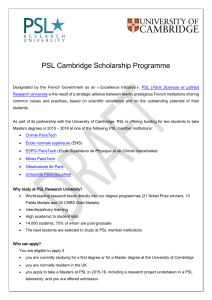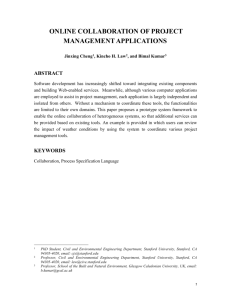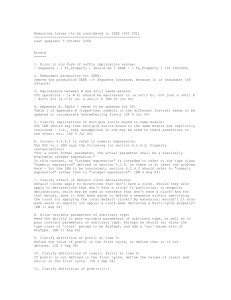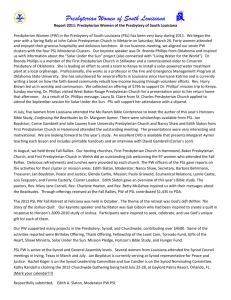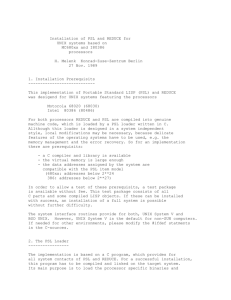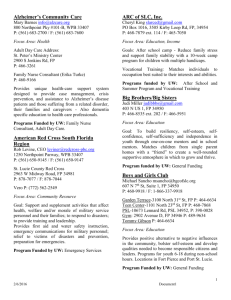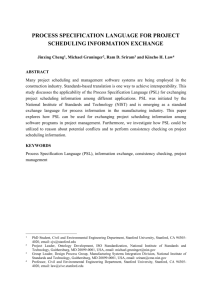3. Distributed Integration Infrastructure
advertisement
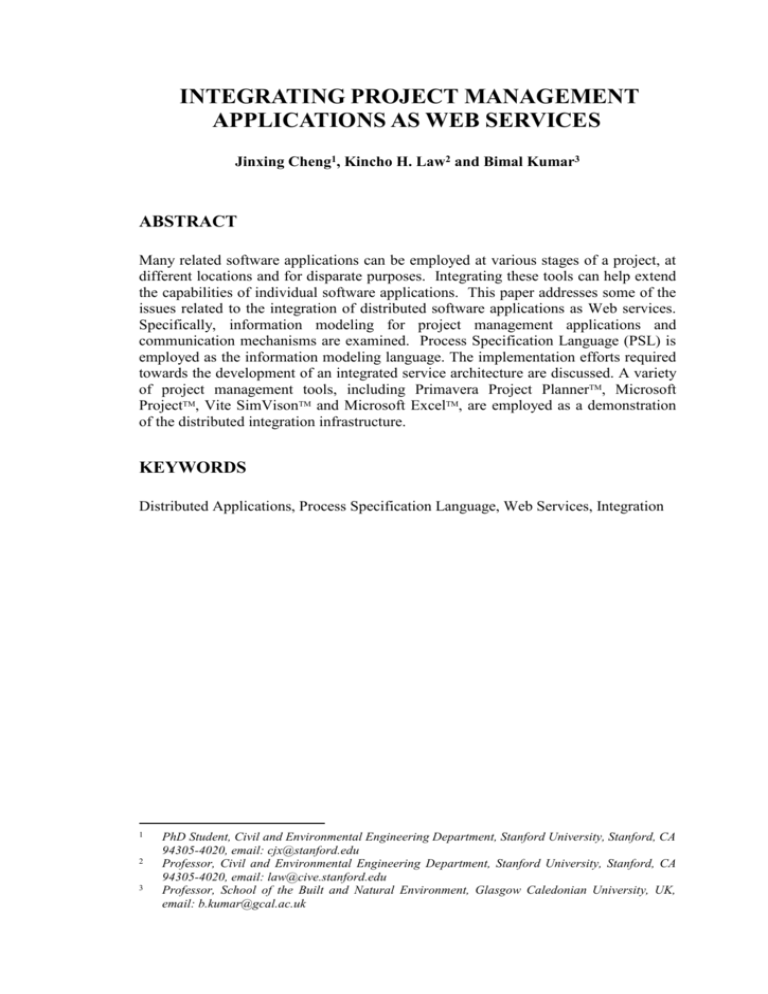
INTEGRATING PROJECT MANAGEMENT
APPLICATIONS AS WEB SERVICES
Jinxing Cheng1, Kincho H. Law2 and Bimal Kumar3
ABSTRACT
Many related software applications can be employed at various stages of a project, at
different locations and for disparate purposes. Integrating these tools can help extend
the capabilities of individual software applications. This paper addresses some of the
issues related to the integration of distributed software applications as Web services.
Specifically, information modeling for project management applications and
communication mechanisms are examined. Process Specification Language (PSL) is
employed as the information modeling language. The implementation efforts required
towards the development of an integrated service architecture are discussed. A variety
of project management tools, including Primavera Project PlannerTM, Microsoft
ProjectTM, Vite SimVisonTM and Microsoft ExcelTM, are employed as a demonstration
of the distributed integration infrastructure.
KEYWORDS
Distributed Applications, Process Specification Language, Web Services, Integration
1
2
3
PhD Student, Civil and Environmental Engineering Department, Stanford University, Stanford, CA
94305-4020, email: cjx@stanford.edu
Professor, Civil and Environmental Engineering Department, Stanford University, Stanford, CA
94305-4020, email: law@cive.stanford.edu
Professor, School of the Built and Natural Environment, Glasgow Caledonian University, UK,
email: b.kumar@gcal.ac.uk
1. INTRODUCTION
Many related software applications can be employed at various stages of a project, at
different locations and for disparate purposes. Integrating these tools can help extend
the capabilities of individual software applications. This paper addresses the issues of
how to integrate distributed software applications as Web services. Specifically,
information modeling for project management applications and communication
mechanisms are examined.
The integration of distributed applications is often complicated by the diverse data
structures and formats employed by the applications. To facilitate the exchange of
information between applications, many efforts have been made with collaboration
from industry, software vendors, academia and standard organizations to define data
exchange standards, such as STEP (ISO 1994), IFC (IAI 1997), ifcXML (Liebich
2001), aecXML (IAI 2002) and others, over the last couple of decades. In this work,
we use Process Specification Language (PSL) as an information modeling language.
PSL was initiated by the National Institute of Standards and Technology (NIST) and is
emerging as a standard exchange language for process information in the
manufacturing industry. While most current data standards deal primarily with product
information, PSL focuses on process information, which is essential for project
management applications. Furthermore, based on first order logic, PSL can potentially
support various reasoning mechanisms beyond data exchange, such as checking
inconsistencies of project information from different sources (Cheng et al. 2002a).
With the proliferation of the Internet, companies are increasingly leveraging the
Internet to achieve competitive advantage. For example, an interactive Web site was
developed and used to disseminate bid packages to contractors and material suppliers
at different locations (Runser et al. 2002). Construction projects are often performed
and managed in a geographically distributed fashion, where a company’s headquarter,
the regional offices and the construction sites are located in different cities, states and
countries. Each office may run its own in-house applications. Integrating software
applications as Web services can potentially remove the barriers of geographic
boundaries and expedite project delivery. An integration framework would require not
only data integration but also network communication in order to achieve
interoperability. In this paper, we describe a prototype infrastructure to integrate
project management applications as Web services.
This paper is organized as follows. In Section 2 we discuss the applicability of
PSL as an information interchange standard for project management applications. In
Section 3 we describe a prototype of a distributed integration infrastructure and
investigate the mechanism of how to provide interoperability among distributed
project management tools. Section 4 provides a sample demonstration of the prototype
system, and Section 5 discusses related works and future extensions.
2. PROCESS SPECIFICATION LANGUAGE
The motivation for the development of the Process Specification Language (PSL) is
twofold. First, few existing standards focus on exchanging process information.
Second, most current standards lack a formal logic to define relationships and
2
constraints. PSL is based on Knowledge Interchange Format (KIF) (Genesereth and
Fikes 1992), which can be used to define terms, relationships and constraints.
The overall organization of the PSL ontology (Schlenoff et al. 2000) includes a set
of core theories, the PSL core, the PSL outer core and PSL Extensions.
PSL core theories are used to define the terms in PSL, so that precise
interpretation of the terms can be obtained.
The PSL core is designed to describe fundamental concepts of manufacturing
processes and includes four basic classes: Object, Activity, ActivityOccurrence and Timepoint. The expressions (beginof LayFoundation) and
(activity_occurrence LayFoundation) are example function and relation,
respectively, in the PSL core.
The PSL outer core consists of a small set of generic extensions, which are
Subactivity Extension, Activity-Occurrence Extension and States Extension.
For example, the expression (subactivity a1 a2) defines a relation over the
activities a1 and a2, in which a2 can be decomposed into a1 and other
activities.
PSL extensions provide the basis for process modeling and information
exchange among different applications within a specific domain. Currently,
standard PSL extensions include various ontology modules, such as generic
activities, ordering relations and schedules. For example, the expression
(before-start occ1 occ2 a3) specifies the relationship among occ1, occ2 and
a3, in which both occ1 and occ2 are subactivity occurrences of the activity a3,
while the beginning timepoint of occ1 is earlier than the beginning timepoint
of occ2.
We have investigated the PSL ontology and compared it with concepts in project
management applications (Cheng et al. 2002a). As shown in Figure 1, a typical project
includes not only scheduling information but also cost, resource, organization and
other information. For example, MS ProjectTM and Primavera Project PlannerTM (P3)
include detailed scheduling information and some rudimentary resource and cost
information. Vite SimVisionTM, a project and organization modeling system, provides
detailed project organization information but rudimentary cost and scheduling
information.
Scheduling
Organization
Resource
Cost
Figure 1: Information in a Construction Project
The current PSL ontology is sufficient for modeling scheduling information. For
example, the function endof specifies the finish date of an activity occurrence, while
the relations before-start and before-start-delay define the “Finish to Start”
dependency relationship between two activity occurrences. The following PSL
expressions indicate that, for the Arnold’s House Project (ARHO), the activity
3
occurrence FrameRoof starts on December 6, 2002 after FrameHouse is finished, and
it lasts 10 days.
(beginof FrameRoof 12/06/2000)
(durationof FrameRoof 10)
(after-start FrameHouse FrameRoof ARHO)
The current PSL ontology also provides limited capabilities for modeling resource
information. For example, the lexicon resource identifies an object required by an
activity and the lexicon demand is used to specify that an activity requires a resource
with nonzero quantity. For example, the concept that InstallDrywall requires 10 pieces
of Drywall can be expressed as:
(resource Drywall)
(demand InstallDrywall Drywall 10)
The ontology about cost and organization information has been proposed and is
currently under development.
PSL has been successfully used to exchange process information among
manufacturing applications. For instance, in a pilot implementation at NIST,
manufacturing process information was successfully exchanged using PSL
information between the IDEF3-based ProCAP and the C++ based ILOG Scheduler
(Schlenoff et al. 1999).
To exchange project information among different
applications, we first need to develop wrappers for each application (Figure 2). The
PSL wrappers are built to retrieve information from applications, to convert the
information into PSL formats, to parse PSL files and to transfer the information to
applications.
P3
PSL
Wrapper
PSL
Wrapper
MS
Project
PSL
Wrapper
MS
Excel
PSL
Vite
PSL
Wrapper
Figure 2: PSL in the Information Exchange
There are three basic steps involved in the translation process between the data
files in PSL format and the applications. The first step is to retrieve the project
information from an application and to update the project model. Semantic mapping
is then performed to translate between the formal PSL ontology and the concepts in
various project management tools. Finally, the project data is syntactically translated
between PSL files and the applications.
Wrappers have been developed for data exchange among various project
management applications. For example, the Primavera Automation Engine (RA) is
employed to develop a PSL wrapper for Primavera Project PlannerTM (P3). The RA is
a set of object-oriented, OLE 2.0-based API, which allows object-oriented
programming access to the P3 scheduling engine. For Microsoft ProjectTM and
Microsoft ExcelTM, VBA (Visual Basic for Application) is utilized. SvEngine, a COM
(Component Object Model) automation object, is used to access a simulation engine
compatible with Vite SimVisionTM. In addition, a translator has been built to translate
the project data between PSL files and a relational database.
4
3. DISTRIBUTED INTEGRATION INFRASTRUCTURE
Different architectures have also been proposed to achieve software integration, such
as localized integration, client-server integration and distributed integration. Localized
integration involves integrating various software tools on one machine, for example a
desktop PC.
In a client-server environment, software integration is often
accomplished using a project repository, which is either a neutral file or a database,
residing on a central server, to which all applications communicate to exchange
information. In a distributed environment, applications are resided on different
computers and are accessed over private or public, local or wide area network.
Web services are distributed services which consist of independent application
components published on the Web (Roy and Ramanujan 2001). These application
components are published in a way that they can be used by other Web applications.
Examples of Web services include a financial market service that provides stock
market information, a weather forecasting service that can be used for construction
planning, and a price quoting service that can be utilized to optimize production plans.
Conceptually, a typical Web service architecture consists of three entities: service
providers, services brokers and service requesters (Roy and Ramanujan 2001).
Service providers develop Web services, register them with service brokers,
and publish them to the Web.
Service brokers act as bridges between service providers and service
requesters; they also maintain detailed lists of published Web services.
Service requesters search the brokers’ lists, find the required services, and send
requests to the corresponding service providers.
To integrate Web services, a data standard needs to be employed, so that results can be
reused by other applications. Network communication issues, such as asynchronous
messaging, also need to be addressed (Bosworth 2001). Furthermore, mechanisms for
invoking and terminating applications over the network need to be provided (Liu et al.
2002b).
The goal of a distributed integration infrastructure is to link application tools, to
act collaboratively on a project, and to allow access to the results using a client’s
device, such as a PDA, a Web browser or a desktop computer, irrespective of time and
space. We have prototyped a distributed integration infrastructure using PSL as the
information interchange standard among different project management tools. As
shown in Figure 3, a communication server and a database system are used to serve as
the backbone of the system. The communication server is responsible for listening
requests from clients, including various applications and client devices. When the
server receives a request, it broadcasts the request to different communication agents.
The communication agents then pick up the request and process it. In addition, an
active mediator is built to act as an information broker between the client devices and
the information sources (Liu et al. 2002a). For example, the user can send a request
from a Web browser (in an XML format). The mediator then sends the request to the
communication server and the database. The results retrieved from the database are
then returned to the mediator, which filters and transforms the results suitable for
display on the client device.
5
Web
Browser
Primavera
P3
Microsoft
Project
Microsoft
Excel
Vite
SimVision
Active
Mediator
PSL Wrapper
PSL Wrapper
PSL Wrapper
PSL Wrapper
XML
Communication
Agent
Communication
Agent
Communication
Agent
Communication
Agent
PSL
Oracle 8i
Relational
Database
Communication
Server
Figure 3: A Distributed Integration Infrastructure
The network communication mechanism for the distributed Web service
infrastructure is illustrated in Figure 4. Java socket communication is used as the
protocol between the communication server and agents. A communication agent
includes an event listener, an event dispatcher, and a data mapper. The messages in
the system include control messages and data messages. Control messages, such as
invoking and termination requests, are typically small in size. Data messages, such as
the project scheduling information and organization information, however, are usually
bigger in size. The event listener receives control messages, while the event dispatcher
sends out control messages. The data mapper is responsible for sending and receiving
data messages.
Figure 5 shows a Java code segment of an event listener. The listener first creates
two data streams: one input stream and one output stream. It then creates a Socket on a
specific port. Finally, it keeps listening on the port to see if there are messages from
the server.
Communication Server
Event
Event
Listener Dispatcher
Data
Mapper
Data Flow
Java Socket Communication
Event
Event
Dispatcher Listener
Control Flow
Data
Mapper
Communication Agent
Figure 4: A Network Communication Framework
Public class ClientListener{
protected DataInputStream i; protected DataOutputStream o;
public static void main (String args[]) throws IOException {
Socket s = new Socket (args[0], Integer.parseInt (args[1]));
ClientListener client = new ClientListener(" " + args[0] + ":"
+ args[1], s.getInputStream (), s.getOutputStream ());
client.waitForEvent();
s.close(); }
public void waitForEvent () {
try { String line = i.readUTF ();}
……}
......
6
}
Figure 5: The Code Segment of an Event Listener
4. DEMONSTRATION
We use the Arnold’s House project from the tutorial example of Vite SimVisionTM to
demonstrate our prototype system. The goal of the project is to build a residential
house on time and within budget. Vite SimVisionTM is used to model the planned work
process and identify major risks, such as task backlogs. Primavera Project PlannerTM
(P3) or Microsoft ProjectTM is used to schedule the project, while Microsoft ExcelTM is
used to display summary information. Figure 6 shows the initial Arnold’s House
project in Vite SimVisionTM, which includes a traditional CPM diagram and project
personnel who are responsible for the activities. Figure 7 presents the schedule
regenerated in Primavera Project PlannerTM.
Figure 6: The Arnold’s House Project In Vite
Figure 7: Project Schedule in Primavera P3
Using the distributed integration infrastructure, we can also view and update the
project on a Web browser, as shown in Figure 8. For example, we can change the
duration of the activity ID120 (“Lay Foundation”) from the original 21 days to 25
days. The communication server then broadcasts the change to various applications,
such as Primavera Project PlannerTM, Microsoft ProjectTM and Vite SimVisionTM.
Figure 9 shows the rescheduled results in Microsoft ProjectTM. The updated schedule
can be sent to Vite SimVisionTM for work process simulation. The re-simulated results
can be retrieved and displayed in Microsoft ExcelTM. For example, Figure 10 shows
the backlog information of different project personnel as displayed in Microsoft
ExcelTM. In particular, we can examine the backlogs of the mason who is responsible
7
for the delayed activity ID120 (“Lay Foundation”). The results of the updated project
information can be retrieved using a Web browser where the delayed activity as well
as the affected activities is highlighted, as shown in Figure 11. It should be noted
here that, throughout the simulation, the software tools are resided on different
computers with different URLs. Furthermore, the changes and updated project
information are stored in the relational database for persistence storage and version
control.
Figure 8: Change Activity Duration on a Web Browser
Figure 9: Updated Project Schedule in Microsoft Project
Figure 10: Re-simulated Results in Microsoft Excel
8
Figure 11: Re-simulated Results on a Web Browser
5. SUMMARY AND DISCUSSIONS
In this paper, we have presented a distributed integration infrastructure, which enables
the integration of distributed applications as Web services. In addition, we have
investigated the use of PSL as an interchange standard and demonstrated the potential
of PSL as an effective ontology standard for project management applications. By
developing a communication agent for each application and a communication server,
data can be exchanged among project management applications regardless of location
and platform.
In this paper, we have focused the discussion of the implementation efforts
required in developing the prototyped integration infrastructure. In other efforts, we
have also investigated ontology mapping issues between PSL and XML-based
schemas (Cheng et al. 2002b). Furthermore, we have begun to explore the possibility
of using the facts expressed in PSL to reason about consistency and to detect conflicts
among project information obtained from different sources (Cheng et al. 2002a). We
have also implemented a mediation-based framework for ubiquitous computing and
distributed engineering services (Liu et al. 2002a). Our current investigation is to
propose a simulation access language and framework to extend the capabilities of
existing project management tools.
6. ACKNOWLEDGEMENT
This work is partially sponsored by a Stanford Graduate Fellowship, the Center for
Integrated Facility Engineering at Stanford University, and the Product Engineering
Program headed by Dr. Ram D. Sriram at NIST. The Product Engineering Program
gets its support from the NIST’s SIMA (Systems Integration for manufacturing
Applications) program and the DARPA’s Radeo Program. The Vite SimVisionTM is
provided by Dr. John Kunz at Stanford University. The authors would like to
acknowledge the contributions by Mr. David Liu in the distributed infrastructure
described in the paper.
9
7. REFERENCES
Bosworth, A. (2001), “Developing Web Services.” Proceedings of the International
Conference on Data Engineering, Heidelberg, Germany, pp. 477-481.
Cheng, J., Law, K.H., Gruninger, M., and Sriram, R.D. (2002a), "Process
Specification Language For Project Information Exchange." Submitted for
publication.
Cheng, J., Trivedi, P., and Law, K.H. (2002b), “Ontology Mapping Between PSL and
XML-Based Standards For Project Scheduling.” 3rd International Conference on
Concurrent Engineering in Construction, Berkeley, CA, pp. 143-156.
Genesereth M.R., and Fikes R. (1992). “Knowledge Interchange Format.” Version 3.0
Reference Manual, Computer Science Department, Stanford University, Stanford,
CA.
IAI (1997). “Industry Foundation Classes.” Specification Volumes 1-4, International
Alliance for Interoperability, Washington, DC.
IAI
(2002).
“AecXML.”
International
Alliance
for
Interoperability,
http://www.aecxml.org (December 2002).
ISO (1994). “Product Data Representation and Exchange: Part 1: Overview and
Fundamental Principles.” No. 10303-1, International Organization for
Standardization.
Liebich, T. (2001). “XML Schema Language Binding of EXPRESS for IfcXML.”
MSG-01-001(Rev 4), International Alliance of Interoperability.
Liu, D., Cheng, J., Law, K.H., and Wiederhold, G. (2002a), “Ubiquitous Computing
Environment for Project Management Services.” Proceedings of the International
Workshop on Information Technology in Civil Engineering, Washington, D.C, pp.
273-285.
Liu D., Law K.H., and Wiederhold G. (2002b), "FICAS: A Distributed Data-Flow
Service Composition Infrastructure." Stanford University, Unpublished Report,
http://mediator.stanford.edu/papers/FICAS.pdf.
Roy, J., and Ramanujan, A. (2001), “Understanding Web services.” IT Professional,
Vol. 3, No. 6, pp. 69-73.
Runser D.J., and Runser J.A. (2002), “Dissemination of Preliminary Design Build Bid
Packages through an Interactive Web Site – An Industry Case Study.” Proceedings
of the International Workshop on Information Technology in Civil Engineering,
Washington, D.C, pp. 357-366.
Schlenoff, C., Ciocoiu, M., Libes, D., and Gruninger, M. (1999). “Process
Specification Language: Results of the First Pilot Implementation.” Proceedings of
the International Mechanical Engineering Congress and Exposition, Vol. 10, pp.
529-539, Nashville, Tennessee.
Schlenoff, C., Gruninger M., Tissot, F., Valois, J., Lubell, J., and Lee, J. (2000). “The
Process Specification Language (PSL): Overview and Version 1.0 Specification.”
NISTIR 6459, National Institute of Standards and Technology, Gaithersburg, MD.
10
